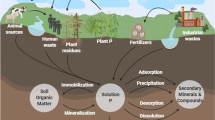Abstract
Sand is the simplest capping material proposed to date to contain phosphorus in sediment in situ. This research was carried out to understand the role of sand capping in the speciation and release of phosphorus from sediment. Clean sand was laid on sediment sampled at a eutrophicated lake in one dimensional columns with different capping thicknesses. It could be understood from the experiments that sand capping with a thickness of less than 50 mm reduced the phosphorus concentration by over 85% and was effective in reducing the amount of phosphorus released from the sediment. Thicker sand capping reduces the amount of phosphorus released from the sediment to a greater extent. Since sand capping retards the release of phosphorus from the sediment, a higher fraction of non-apatite P (NA-P) was able to be converted into the less soluble Apatite-P (AP).
Similar content being viewed by others
References
APHA, AWWA, WEF (1998). Standard methods for the examination of water and wastewater, 20th ed., APHA, Washington DC.
Azcue, J. M., Zeman, A. J., Mudroch, A., Rosa, F., and Patterson, T. (1998). “Assessment of sediment and porewater after one year of subaqueous capping of contaminated sediments in Hamilton Harbour, Canada.” Water Science and Technology, Vol. 37, No. 6, pp. 323–329.
Berg, U., Neumann, T., Donnert, D., Nuesch, R., and Stuben, D. (2004). “Sediment capping in eutrophic lakes-efficiency of undisturbed calcite barriers to immobilize phosphorus.” Applied Geochemistry, Vol. 19, No. 11, pp. 1759–1771.
Clarke, S. J. (2002). “Vegetation growth in rivers: Influences upon sediment and nutrient dynamics.” Progress in Physical Geography, Vol. 26, No. 2, pp. 159–172.
Effler, S. W., Wagner, B. A., O’Donnell, S. M., Matthews, D. A., O’Donnell, D. M., Gelda, R. K., Matthews, C. M., and Cowen, E. A. (2004). “An upwelling event at Onondaga Lake, NY: Characterization, impact and recurrence.” Hydrobiologia, Vol. 511, No. 1–3, pp. 185–199.
Gachter, R. and Meyer, J. S. (1993). “The role of microorganisms in mobilization and fixation of phosphorus in sediments.” Hydrobiologia, Vol. 253, No. 1–3, pp. 103–121.
Hieltjes, A. H. M. and Lijklema, L. (1980). “Fractionation of inorganic phosphates in calcareous sediments.” Journal of Environmental Quality, Vol. 9, No. 3, pp. 405–407.
House, W. A. and Denison, F. H. (1997). “Nutrient dynamics in a lowland stream impacted by sewage effluent: Great Ouse, England.” Science of the Total Environment, Vol. 205, No. 1, pp. 25–49.
Jacobs, P. H. and Forstner, U. (1999). “Concept of subaqueous capping of contaminated sediments with Active Barrier Systems (ABS) using natural and modified zeolites.” Water Research, Vol. 33, No. 9, pp. 2083–2087.
Jin, X. C., Wang, S. R., Pang, Y., and Wu, F. C. (2006). “Phosphorus fractions and the effect of pH on the phosphorus release of the sediments from different trophic areas in Taihu Lake, China.” Environmental Pollution, Vol. 139, No. 2, pp. 288–295.
Kuwabara, J. S., Carter, J. L., Topping, B. R., Fend, S. V., Woods, P. F., Berelson, W. M., and Balistrieri, L. S. (2003). “Importance of sediment-water interactions in Coeur d’Alene Lake, Idaho, USA: Management implications.” Environmental Management, Vol. 32, No. 3, pp. 348–359.
Mohan, R. K., Brown, M. P., Barnes, C. R. (2000). “Design criteria and theoretical basis for capping contaminated marine sediments.” Applied Ocean Research, Vol. 22, No. 2, pp. 85–93.
Moore, P. A. and Reddy, K. R. (1994). “Role of Eh and Ph on phosphorus geochemistry in sediments of lake okeechobee, florida.” Journal of Environmental Quality, Vol. 23, No. 1994, pp. 955–964.
Palermo, M. R. (1998). “Design considerations for in-situ capping of contaminated sediments.” Water Science and Technology, Vol. 37, No. 6–7, pp. 315–321.
Quaak, M., Vanderdoes, J., Boers, P., and Vandervlugt, J. (1993). “A new technique to reduce internal phosphorus loading by in-lake phosphate fixation in shallow lakes.” Hydrobiologia, Vol. 253, No. 1–3, pp. 337–344.
Schnoor, J. L. (1996). Environmental modeling, John Wiley & Sons, Inc., New York.
Skaggs, R. W., Breve, M. A., and Gilliam, J. W. (1994). “Hydrologic and water-quality impacts of agricultural drainage.” Critical Reviews in Environmental Science and Technology, Vol. 24, No. 1, pp. 1–32.
USDA (1999). Soil taxonomy: A basic system of soil classification for making and interpreting soil surveys, United States Department of Agriculture, Natural Resources Conservations Service.
Wang, H., Appan, A., and Gulliver, J. S. (2003). “Modeling of phosphorus dynamics in aquatic sediments: I — model development.” Water Research, Vol. 37, No. 16, pp. 3928–3938.
Wang, S. R., Jin, X. C., Pang, Y., Zhao, H. C., and Zhou, X. N. (2005). “The study of the effect of pH on phosphate sorption by different trophic lake sediments.” Journal of Colloid and Interface Science, Vol. 285, No. 2, pp. 448–457.
Wauer, G., Gonsiorczyk, T., Kretschmer, K., Casper, P., and Koschel, R. (2005). “Sediment treatment with a nitrate-storing compound to reduce phosphorus release.” Water Research, Vol. 39,No. 2–3, pp. 494–500.
Author information
Authors and Affiliations
Corresponding author
Rights and permissions
About this article
Cite this article
Kim, G., Jung, W. Role of sand capping in phosphorus release from sediment. KSCE J Civ Eng 14, 815–821 (2010). https://doi.org/10.1007/s12205-010-0856-3
Received:
Revised:
Accepted:
Published:
Issue Date:
DOI: https://doi.org/10.1007/s12205-010-0856-3




